 W
WHuman body shape is a complex phenomenon with sophisticated detail and function. The general shape or figure of a person is defined mainly by the molding of skeletal structures, as well as the distribution of muscles and fat. Skeletal structure grows and changes only up to the point at which a human reaches adulthood and remains essentially the same for the rest of their life. Growth is usually completed between the ages of 13 and 18, at which time the epiphyseal plates of long bones close, allowing no further growth.
 W
WAir displacement plethysmography is a recognized and scientifically validated densitometric method to measure human body composition. ADP is based on the same principles as the gold standard method of hydrostatic weighing, but through a densitometric technique that uses air displacement rather than water immersion. Air-displacement plethysmography offers several advantages over established reference methods, including a quick, comfortable, automated, noninvasive, and safe measurement process, and accommodates various subject types.
 W
WBeefcake is a performance or a form of glamour photography depicting a large and muscular male body. Beefcake is also a publication genre. A role a person plays in a performance may be called beefcake. The term was believed to be first used by Hollywood columnist Sidney Skolsky.
 W
WBody dysmorphic disorder (BDD), occasionally still called dysmorphophobia, is a mental disorder characterized by the obsessive idea that some aspect of one's own body part or appearance is severely flawed and therefore warrants exceptional measures to hide or fix it. In BDD's delusional variant, the flaw is imagined. If the flaw is actual, its importance is severely exaggerated. Either way, thoughts about it are pervasive and intrusive, and may occupy several hours a day, causing severe distress and impairing one's otherwise normal activities. BDD is classified as a somatoform disorder, and the DSM-5 categorizes BDD in the obsessive–compulsive spectrum, and distinguishes it from anorexia nervosa.
 W
WBody mass index (BMI) is a value derived from the mass (weight) and height of a person. The BMI is defined as the body mass divided by the square of the body height, and is expressed in units of kg/m2, resulting from mass in kilograms and height in metres.
 W
WBodybuilding is the use of progressive resistance exercise to control and develop one's muscles by muscle hypertrophy for aesthetic purposes. It is distinct from similar activities such as powerlifting because it focuses on physical appearance instead of strength. An individual who engages in this activity is referred to as a bodybuilder. In professional bodybuilding, competitors appear in lineups and perform specified poses for a panel of judges who rank them based on symmetry, muscularity, size, conditioning, posing, and stage presentation. Bodybuilders prepare for competitions through the elimination of nonessential body fat, enhanced at the last stage by a combination of extracellular dehydration and carbo-loading, to achieve maximum muscular definition and vascularity; they also tan and shave to accentuate the contrast of their skin under the spotlights.
 W
WA bustline is an arbitrary line encircling the fullest part of the bust or body circumference at the bust. It is a body measurement which measures the circumference of a woman's torso at the level of the breasts. It is measured by keeping a measuring tape horizontal and wrapping it around the body so that it goes over the nipples and under the arms.
 W
WA dysmorphic feature is an abnormal difference in body structure. It can be an isolated finding in an otherwise normal individual, or it can be related to a congenital disorder, genetic syndrome or birth defect. Dysmorphology is the study of dysmorphic features, their origins and proper nomenclature. One of the key challenges in identifying and describing dysmorphic features is the use and understanding of specific terms between different individuals. Clinical geneticists and pediatricians are usually those most closely involved with the identification and description of dysmorphic features, as most are apparent during childhood.
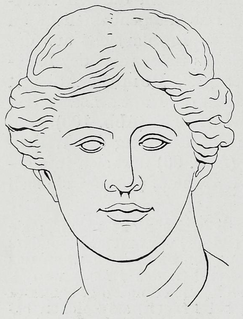 W
WFacial symmetry is one specific measure of bodily symmetry. Along with traits such as averageness and youthfulness it influences judgments of aesthetic traits of physical attractiveness and beauty. For instance, in mate selection, people have been shown to have a preference for symmetry.
 W
WThe hourglass figure is one of four traditional female body shapes described by the fashion industry. The other shapes are the rectangular, inverted triangle, and spoon/pear. The hourglass shape is defined by a woman's body measurements- the circumference of the bust, waist and hips. Hourglass body shapes have a wide bust, a narrow waist, and wide hips with a similar measurement to that of the bust. This body shape is named for its resemblance to that of an hourglass where the upper and lower half are wide and roughly equal while the middle is narrow in circumference, making the overall shape wide-narrow-wide. Women who exhibit the hourglass figure have been shown to be more admired, which can put pressure on women whose body shapes are noticeably different to strive to achieve the hourglass figure. This can lead to body dissatisfaction which can cause eating disorders in young women from all over the globe.
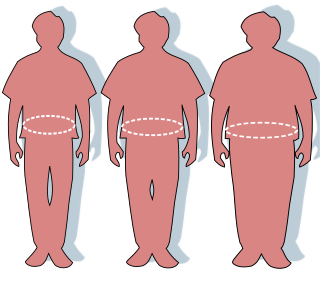 W
WObesity is a medical condition in which excess body fat has accumulated to an extent that it may have a negative effect on health. People are generally considered obese when their body mass index (BMI), a measurement obtained by dividing a person's weight by the square of the person's height—despite known allometric inaccuracies—is over 30 kg/m2; the range 25–30 kg/m2 is defined as overweight. Some East Asian countries use lower values. Obesity is correlated with various diseases and conditions, particularly cardiovascular diseases, type 2 diabetes, obstructive sleep apnea, certain types of cancer, and osteoarthritis. High BMI is a marker of risk, but not proven to be a direct cause, for diseases caused by diet, physical activity, and environmental factors. A reciprocal link has been found between obesity and depression, with obesity increasing the risk of clinical depression and also depression leading to a higher chance of developing obesity.
 W
WObesity and the environment aims to look at the different environmental factors that have been determined by researchers to cause and perpetuate obesity. In 1994 in the United States, the percentage of the adult population that was obese was much lower than it is today. In 1994 the percentage of the population in every state that was obese was less than 20%, but by 2008, only one state still had a percentage obese below 20%, six states had a percentage obese of more than 30% while the rest of the states ranged between 20% and 30%. In 2016, the number of obese people reached an all-time high of about 93 million, which was up 33 percent from 2008 according to the Center for Disease Control (CDC). This may be even more concerning for children and teens who have seen their rate of obesity go up to 18.5%, which is triple the rate in 1980. If current trends continue, as many as 57% of them will end up obese by the time, they reach the age of 35. This will put them at higher risk for other health conditions such as, Type 2 diabetes, heart disease, and cancer. In response, both federal and local officials have instituted policies to combat obesity as well as promote healthy eating, such as: The Farm Bill, National School Lunch Act and Child Nutrition Act, as well as The Healthy Kid Act.
 W
WObesogens are foreign chemical compounds that are hypothesised to disrupt normal development and balance of lipid metabolism, which in some cases, can lead to obesity. Obesogens may be functionally defined as chemicals that inappropriately alter lipid homeostasis and fat storage, change metabolic setpoints, disrupt energy balance or modify the regulation of appetite and satiety to promote fat accumulation and obesity.
 W
WA sauna suit is a garment made from waterproof fabric designed to make the wearer sweat profusely. A sauna suit is sometimes called a "rubber suit" because the early types were made of rubber or rubberized cloth. Now, sauna suits are typically made of PVC or coated nylon cloth. The construction is typically in the style of a waterproof sweat suit, consisting of a pullover jacket and drawstring pants. The closures at waist, neck, wrists and ankles are all elasticated to help retain body heat and moisture within the garment. In some sauna suits, the jacket also includes a hood to provide additional retention of body heat.
 W
WA thigh gap is a space between the inner thighs of some people when standing upright with feet touching.
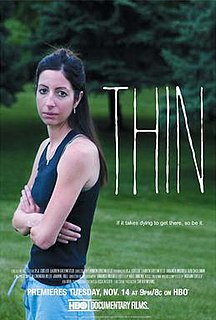 W
WThin is a 2006 cinéma vérité documentary film directed by Lauren Greenfield and distributed by HBO. It was filmed at The Renfrew Center of Florida in Coconut Creek, a 40-bed residential facility for the treatment of women with eating disorders. The film follows four women with anorexia nervosa, bulimia nervosa and other eating disorders in their struggle for recovery. It premiered to the general public November 14, 2006 on HBO.
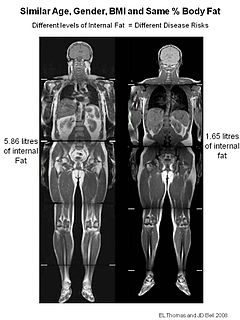 W
WTOFI (thin-outside-fat-inside) is used to describe lean individuals with a disproportionate amount of fat stored in their abdomen. The figure to illustrate this shows two men, both 35 years old, with a BMI of 25 kg/m2. Despite their similar size, the TOFI had 5.86 litres of internal fat, whilst the healthy control had only 1.65 litres.
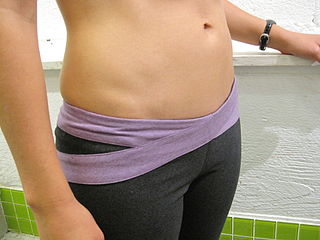 W
WTucking is a technique whereby an individual hides the crotch bulge of the penis and testicles so that they are not conspicuous through clothing.
 W
WThe waist-hip ratio or waist-to-hip ratio (WHR) is the dimensionless ratio of the circumference of the waist to that of the hips. This is calculated as waist measurement divided by hip measurement. For example, a person with a 30″ (76 cm) waist and 38″ (97 cm) hips has a waist-hip ratio of about 0.78.